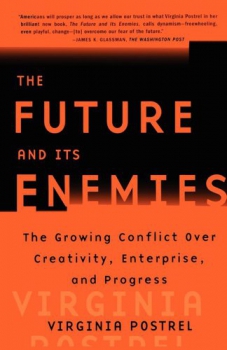In my previous essay, I discussed a new white paper by my colleague Robert Graboyes, Fortress and Frontier in American Health Care, which examines the future of medical innovation. Graboyes uses the “fortress vs frontier” dichotomy to help explain different “visions” about how public policies debates about technological innovation in the health care arena often play out. It’s a terrific study that I highly recommend for all the reasons I stated in my previous post.
As I was reading Bob’s new report, I realized that his approach shared much in common with a couple of other recent innovation policy paradigms I have discussed here before from Virginia Postrel (“Stasis” vs. “Dynamism”), Robert D. Atkinson (“Preservationists” vs. “Modernizers”), and myself (“Precautionary Principle” vs. “Permissionless Innovation”). In this essay, I will briefly relate Bob’s’ approach to those other three innovation policy paradigms and then note a deficiency with our common approaches. I’ll conclude by briefly discussing another interesting framework from science writer Joel Garreau.
Stasis vs. Dynamism – Virginia Postrel (1998)
 In her 1998 book, The Future and Its Enemies, Virginia Postrel contrasted the conflicting worldviews of “dynamism”and “stasis” and showed how the tensions between these two visions would affect the course of future human progress. Postrel made the case for embracing dynamism — “a world of constant creation, discovery, and competition” — over the “regulated, engineered world” of the stasis mentality. She argued that we should “see technology as an expression of human creativity and the future as inviting” and reject the idea “that progress requires a central blueprint.” Dynamism defines progress as “a decentralized, evolutionary process” in which mistakes aren’t viewed as permanent disasters but instead as “the correctable by-products of experimentation.” (p. xiv)
In her 1998 book, The Future and Its Enemies, Virginia Postrel contrasted the conflicting worldviews of “dynamism”and “stasis” and showed how the tensions between these two visions would affect the course of future human progress. Postrel made the case for embracing dynamism — “a world of constant creation, discovery, and competition” — over the “regulated, engineered world” of the stasis mentality. She argued that we should “see technology as an expression of human creativity and the future as inviting” and reject the idea “that progress requires a central blueprint.” Dynamism defines progress as “a decentralized, evolutionary process” in which mistakes aren’t viewed as permanent disasters but instead as “the correctable by-products of experimentation.” (p. xiv)
Postrel argued that our dynamic modern world and the amazing technologies that drive it have united diverse “stasis”-minded forces in opposition to its continued, unfettered evolution:
[It] has united two types of stasists who would have once been bitter enemies: reactionaries, whose central value is stability, and technocrats, whose central value is control. Reactionaries seek to reverse change, restoring the literal or imagined past and holding it in place. . . . Technocrats, for their part, promise to manage change, centrally directing “progress” according to a predictable plan. . . . They do not celebrate the primitive or traditional. Rather, they worry about the government’s inability to control dynamism. (p. 7-8)
Preservationists vs. Modernizers – Robert D. Atkinson (2004)
 Robert D. Atkinson, President, Information Technology and Innovation Foundation, presented another useful way of looking at innovation policy divides in his 2004 book, The Past and Future of America’s Economy. In Chapter 6 on “The New Economy and Its Discontents,” Atkinson noted how “American history is rife with resistance to change,” as he recounted some of the heated battles over previous industrial / technological revolutions. He argued:
Robert D. Atkinson, President, Information Technology and Innovation Foundation, presented another useful way of looking at innovation policy divides in his 2004 book, The Past and Future of America’s Economy. In Chapter 6 on “The New Economy and Its Discontents,” Atkinson noted how “American history is rife with resistance to change,” as he recounted some of the heated battles over previous industrial / technological revolutions. He argued:
This conflict between stability and progress, security and prosperity, dynamism and stasis, has led to the creation of a major political fault line in American politics. On one side are those who welcome the future and look at the New Economy as largely positive. On the other are those who resist change and see only the risks of new technologies and the New Economy. As a result, a political divide is emerging between preservationists who want to hold onto the past and modernizers who recognize that new times require new means. (p. 201)
Precautionary Principle vs. Permissionless Innovation – Adam Thierer (2014)
 In my latest book, “Permissionless Innovation: The Continuing Case for Comprehensive Technological Freedom,” I argued that the central fault line in almost all modern technology policy debates revolves around “the permission question,” which asks: Must the creators of new technologies seek the blessing of public officials before they develop and deploy their innovations? I argued that we are today witnessing a grand clash of visions between two competing mindsets about how that question should be answered for a wide variety of new inventions:
In my latest book, “Permissionless Innovation: The Continuing Case for Comprehensive Technological Freedom,” I argued that the central fault line in almost all modern technology policy debates revolves around “the permission question,” which asks: Must the creators of new technologies seek the blessing of public officials before they develop and deploy their innovations? I argued that we are today witnessing a grand clash of visions between two competing mindsets about how that question should be answered for a wide variety of new inventions:
One disposition is known as the “precautionary principle.” Generally speaking, it refers to the belief that new innovations should be curtailed or disallowed until their developers can prove that they will not cause any harms to individuals, groups, specific entities, cultural norms, or various existing laws, norms, or traditions.
The other vision can be labeled “permissionless innovation.” It refers to the notion that experimentation with new technologies and business models should generally be permitted by default. Unless a compelling case can be made that a new invention will bring serious harm to society, innovation should be allowed to continue unabated and problems, if they develop at all, can be addressed later.
Fortress vs. Frontier – Robert Graboyes (2014)
 In his new white paper, Fortress and Frontier in American Health Care, Robert Graboyes seeks to reframe the debate over the future of health care innovation in terms of “Fortress versus Frontier” and to highlight what lessons we can learn from the Internet and the Information Revolution that can better inform health care policy. Graboyes defines “Fortress and Frontier” as follows:
In his new white paper, Fortress and Frontier in American Health Care, Robert Graboyes seeks to reframe the debate over the future of health care innovation in terms of “Fortress versus Frontier” and to highlight what lessons we can learn from the Internet and the Information Revolution that can better inform health care policy. Graboyes defines “Fortress and Frontier” as follows:
The Fortress is an institutional environment that aims to obviate risk and protect established producers (insiders) against competition from newcomers (outsiders). The Frontier, in contrast, tolerates risk and allows outsiders to compete against established insiders. . . . The Fortress-Frontier divide does not correspond neatly with the more familiar partisan or ideological divides. Framing health care policy issues in this way opens the door for a more productive national health care discussion and for unconventional policy alliances. (p. 4)
He elaborates in more detail later in the paper:
the Frontier encourages creative destruction and disruptive innovation. Undreamed-of products arise and old, revered ones vanish. New production processes sweep away old ones. This is a place where unknown innovators in garages destroy titans of industry. The Frontier celebrates and rewards risk, and there is a brutal egalitarianism to the creative process. In contrast, the Fortress discourages creative destruction and disruptive innovation. Insiders are protected from competition by government or by private organizations (such as insurers and medical societies) acting in quasigovernmental fashion. In the Fortress, insiders preserve the existing order. Innovation comes from well-established, credentialed insiders who, it is presumed, have the wisdom and motives and competence to identify opportunities for innovation. (p. 13)
The Common Themes
There are several themes that unify these four frameworks. Most notably, they all seek to escape the traditional “Left vs. Right,” “Conservative vs. Liberal,” and “Democrat vs. Republican” labels and models. Postrel’s book noted that, although there are differences at the margin, “reactionaries” (who tend to be more politically and socially “conservative”) and “technocrats” (who tend to identify as politically “progressive”) are united by their desire for greater control over the pace and shape of technological innovation. They both hope that sagacious, noble-minded public officials can set us on a “better path,” or return us to an old path from which we have drifted.
Similarly, Atkinson’s “preservationists versus modernizers” dichotomy identified the “small-c” conservatism that animates the preservationist mindset, regardless of which party or political movement they belong to. Graboyes and I identify this same tendency of those with a precautionary, Fortress mindset to be deeply suspicious of change, and sometimes even being quite openly hostile to it–regardless of their political affiliation. Moreover, all four authors note that, at a minimum, Stasis/Preservationist/Fortress/Precautionary vision is unified by a general gloominess about the prospect for technological change to really better our economy or culture.
From a policy perspective, the competing visions outlined in each of these four paradigms are unified by their preferred policy default for new innovation. Generally speaking, those subscribing to the Dynamist/Modernizer/Frontier/Permissionless Innovation vision believe that innovators should have a clear green light to experiment without fear of prior restraint. By contrast, those adhering to the Stasis/Preservationist/Fortress/Precautionary vision are more risk-adverse and tend to opt for “better to be safe than sorry” policy defaults.
Here’s a little table I put together to highlight the “conflict of visions” over innovation policy identified in these works.
| Innovation Policy: The Conflict of Visions | |
| “Stasis” | “Dynamism” |
| “Preservationists” | “Modernizers” |
| “Precautionary principle” | “Permissionless innovation” |
| “Fortress” | “Frontier” |
| progress should be carefully guided | progress should free-wheeling |
| fear of risk & uncertainty | embrace of risk & uncertainty |
| stability/safety first | spontaneity first |
| equilibrium | experimentation |
| wisdom through better planning | wisdom through trial & error |
| anticipation & regulation | adaptation & resiliency |
| ex ante solutions | ex post solutions |
| “better to be safe than sorry” | “nothing ventured, nothing gained” |
A Problem with These Paradigms
An astute reader will notice a potential problem with these four paradigms: They were crafted by people (including myself) who were much more favorably disposed to one vision than the other. In fact, each of the authors listed here (including me) firmly embraced a common “positive” or “optimistic” vision about the potential for innovation and technological change to generally boost human welfare. We were all writing defenses of visions that, generally speaking, encourage the adoption of attitudes and public policies that are generally welcoming toward new innovations. Postrel, for example, was seeking to articulate and defend the superiority of the dynamist vision over the stasis mentality. Atkinson defended modernizers and bashed preservationists. Graboyes embraced the Frontier mentality and warned of the dangers of the Fortress mentality. Finally, in my own work, I have vociferously defended the notion of permissionless innovation while repeatedly criticizing precautionary principle-based thinking.
I will proudly defend my own work as well as the visions sketched out by Postrel, Atkinson, and Graboyes, which are all very much in league with my own. Nonetheless, some readers or critics might claim that we have stacked the deck in our favor by framing innovation policy debates in the ways we have. We each had a polemical purpose in mind when writing these books; we were hoping to convince others to embrace our way of thinking about technological progress and the future. As a result, that influenced our choice of language and labels. Some critics might even claim that the words we chose to describe the alternative vision are too simplistic or unfairly derogatory. After all, who wants to be labeled a “stasis”-minded “preservationist” who is trapped in a “fortress” mentality advocating hopelessly “precautionary” policies?! By contrast, it is relatively easy for many of us to say we are “modernizers” who embrace “dynamism” and the “frontier” spirit in defense of “permissionless innovation.”
Technological critics have penned a wide variety of polemics making their views on these matters clear, but what is interesting is how few of them attempt to describe the opposing positions in clear detail, or even bother trying to label them. Nor do they usually bother labeling their own positions or perspectives. I suspect that many of them would claim their visions or critiques cannot be succinctly summarized in a mere word or phrase, and that trying to craft conflicting “visions” about innovation policy over-simplifies very complex matters. I actually appreciate that point more than you think. When I am writing about these matters, I try not to over-generalize the very nuanced, sensitive issues in play in here, such as the privacy, safety, and security implications associated with various new innovations. These are profound matters and they deserve to be analyzed carefully and respectfully.
That being said, I still believe that there is a role for visions when thinking about the past, the present, and the future of technological change. Labels and classifications can help us unpack the philosophical differences between different people and organizations and then also evaluate their preferred policy solutions. This allows us to better understand what animates the opposing forces that are pushing for specific policy changes.
Nonetheless, I welcome alternative framings of these proposals and the personalities behind them. Moreover, I would very much like to see others — either those who take opposing views, or analysts with no stake in the fight — suggest other ways of looking at the conflict of visions that animates debates over technological innovation and the future of progress.
A Note on Joel Garreau’s Framing
 I want to close with a quick postscript related to my point about over-simplifying “visions” about technological change. In 2010, I penned an essay that got a fair amount of attention entitled, “Are You An Internet Optimist or Pessimist? The Great Debate over Technology’s Impact on Society.” As the title implied, it was an attempt to divide the history of thinking about technological innovation into two camps: “pessimists” and “optimists.” It was a crude and overly-simplistic dichotomy, but it was an attempt to begin sketching out a rough taxonomy of the personalities and perspectives that we often seen pitted against each other in debates about the impact of technology on culture and humanity.
I want to close with a quick postscript related to my point about over-simplifying “visions” about technological change. In 2010, I penned an essay that got a fair amount of attention entitled, “Are You An Internet Optimist or Pessimist? The Great Debate over Technology’s Impact on Society.” As the title implied, it was an attempt to divide the history of thinking about technological innovation into two camps: “pessimists” and “optimists.” It was a crude and overly-simplistic dichotomy, but it was an attempt to begin sketching out a rough taxonomy of the personalities and perspectives that we often seen pitted against each other in debates about the impact of technology on culture and humanity.
I was never really satisfied with the “optimist vs. pessimist” breakdown, and I got an earful from some people about it. I always thought there must be somebody who had figured out a better way of reviewing the long arc of history and human thinking about technological change and coming up with better labels or “visions.” And there was!
When I wrote that earlier piece, I was unfortunately not aware of a similar (and much better) framing of this divide that was developed by science and technology writer Joel Garreau in his outstanding 2005 book, Radical Evolution: The Promise and Peril of Enhancing Our Minds, Our Bodies — and What It Means to Be Human. In that book, Garreau is thinking in much grander terms about technology and the future than I was in my earlier essay. He was focused on how various emerging technologies might be changing our very humanity and he notes that narratives about these issues are typically framed in “Heaven” versus “Hell” scenarios.
Under the “Heaven” scenario, technology drives history relentlessly, and in almost every way for the better. As Garreau describes the beliefs of the Heaven crowd, they believe that going forward, “almost unimaginably good things are happening, including the conquering of disease and poverty, but also an increase in beauty, wisdom, love, truth, and peace.” (p. 130) By contrast, under the “Hell” scenario, “technology is used for extreme evil, threatening humanity with extinction.” (p. 95) Garreau notes that what unifies the Hell scenario theorists is the sense that in “wresting power from the gods and seeking to transcend the human condition,” we end up instead creating a monster — or maybe many different monsters — that threatens our very existence. Garreau says this “Frankenstein Principle” can be seen in countless works of literature and technological criticism throughout history, and it is still very much with us today. (p. 108)
After discussing the “Heaven” and “Hell” scenarios cast about by countless tech writers throughout history, Garreau outlined a third, and more pragmatic “Prevail” option, which views history “as a remarkably effective paean to the power of humans to muddle through extraordinary circumstances.” As Garreau explains it, under the “Prevail” scenario, “humans shape and adapt [technology] in entirely new directions.” (p. 95) “Just because the problems are increasing doesn’t mean solutions might not also be increasing to match them,” he rightly notes. (p. 154)
That pretty much sums up my own perspective on things, as I noted in this essay earlier this year, “Muddling Through: How We Learn to Cope with Technological Change.” I think the “prevail” or “muddling through” notion offers the best explanation for how we learn to cope with technological disruption and prosper in the process. (I also wrote a lengthy law review article on this and discussed this issue more in my recent book.) In any event, I chose not to include Garreau’s framework in the above discussion because Garreau — a former reporter and editor at The Washington Post — tries to be somewhat more objective in discussing the various “Heaven” vs. “Hell” scenarios and the personalities behind them (even though in the concluding chapter he seems to be aligning himself with the “Prevail” crowd.) So, it doesn’t quite align perfectly with the more polemical visions I described above. But I continue to think it is the single best thing penned in recent years on the nature of these debates. I cannot recommend it strongly enough.
In closing, I want to reiterate that I would very much welcome suggestions from others about alternative framings and paradigms for thinking about the future of technological change and progress. I imagine I will spend the rest of my life researching and writing about these issues, so I’d love to get more input. As you can tell, I find these debates terrifically interesting!

 The Technology Liberation Front is the tech policy blog dedicated to keeping politicians' hands off the 'net and everything else related to technology.
The Technology Liberation Front is the tech policy blog dedicated to keeping politicians' hands off the 'net and everything else related to technology.